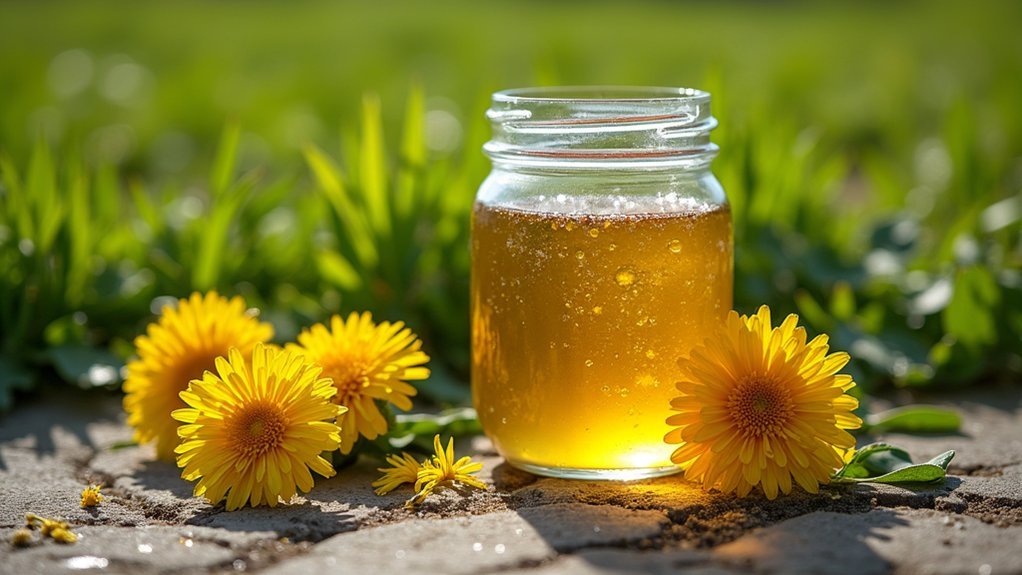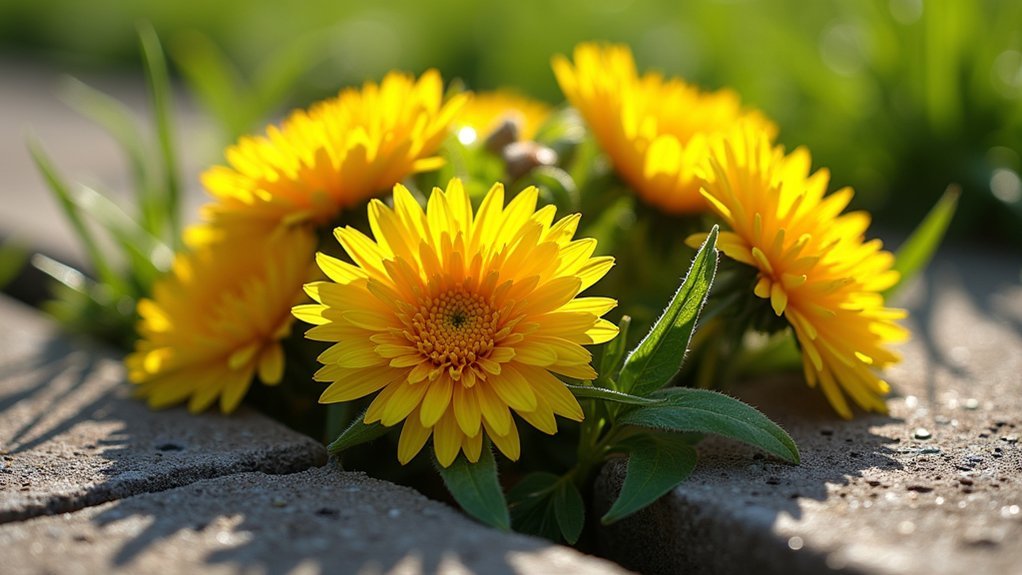For city dandelion wine, harvest in mid-morning from pesticide-free community gardens and urban parks, avoiding roadside flowers that may be contaminated. Collect only golden petals on sunny mid-spring days (late March to early May) for ideal sweetness. Connect with local foraging communities to discover prime gathering spots and share wine-making techniques. These urban foraging strategies will transform your dandelion harvest into a delicious homemade wine worth toasting to.
3 Best Dandelion Wine Tips For City Foragers

While many urbanites overlook the humble dandelion, these golden blooms offer a perfect opportunity for city dwellers to transform local flora into delicious homemade wine.
When foraging, seek sunny pesticide-free areas like community gardens where dandelion flowers thrive naturally.
Harvest dandelion blooms mid-morning when fully open, collecting three quarts of flower petals per gallon of wine. Avoid green parts to prevent bitterness.
For perfect wine, pluck dandelions at morning's peak, focusing only on golden petals while leaving bitter greens behind.
Enhance your homemade dandelion wine with organic citrus fruits—lemons and oranges add zest and balance the sweetness perfectly.
Carefully monitor the fermentation process, as urban environments can affect bubbling activity. The typical 1-2 week duration may vary with city temperature and humidity fluctuations.
Connect with local foraging communities to discover prime gathering spots and exchange wine making techniques, creating both wonderful beverages and meaningful relationships.
Finding Safe Harvesting Spots in Urban Environments
Despite concrete jungles dominating cityscapes, safe dandelion harvesting locations exist for resourceful urban foragers. Urban parks and community gardens offer prime spots where pesticides and chemicals are less frequently used, yielding cleaner flowers for your wine.
Always check local guidelines before harvesting—some cities restrict foraging in public spaces. Time your expeditions for sunny days, preferably mid-morning when flowers fully open, making petal collection easier.
Avoid dandelions growing near busy roads where vehicle emissions and runoff contaminate plants. Instead, seek out residential areas with abundant growth, but remember to ask permission before harvesting from private gardens.
Building relationships with local gardeners can be mutually beneficial—they'll appreciate your help removing what they consider weeds, while you'll gain access to chemical-free harvesting spots.
Timing Your Urban Harvest for Maximum Flavor

Since timing dramatically impacts the flavor profile of your dandelion wine, choosing the perfect moment to harvest is essential for city foragers.
To collect dandelion flower heads with maximum flavor, you'll need to coordinate your urban harvesting with nature's schedule.
- Target mid-spring mornings when flowers are fully open and vibrant, typically between late March and early May.
- Harvest dandelions on sunny days when petals reach their peak blooming period for ideal sweetness.
- Select an area without pesticides to guarantee your urban harvest remains chemical-free.
- Plan to gather three quarts (approximately 12 cups) of petals before they go to seed to preserve their floral notes.
Frequently Asked Questions
How Many Dandelions Does It Take to Make a Gallon of Wine?
You'll need about 3 quarts (12 cups) of dandelion petals to make one gallon of wine. Remember, you're only using the yellow petals, not the green parts which can make your wine bitter.
Should Dandelion Wine Be Chilled?
Yes, you'll want to chill your dandelion wine before serving. The ideal temperature is between 45-55°F to enhance its invigorating qualities, balance sweetness, and highlight the delicate floral and citrus notes.
Does Dandelion Wine Age Well?
Yes, your dandelion wine ages wonderfully! It's best after at least six months, with flavors mellowing from harsh to complex and balanced. You'll enjoy it most within a year, though it can age longer.
Is Dandelion Wine Good for the Liver?
Dandelion wine can benefit your liver when consumed moderately. It contains compounds that promote detoxification and bile production while offering antioxidants that combat oxidative stress. Don't overdo it though—it's still alcoholic.
In Summary
You're now ready to craft exquisite dandelion wine right from your urban landscape. Remember to stay away from busy roadways, always ask permission on private property, and choose flowers at their peak morning bloom. With these three tips, you'll transform those golden "weeds" into a delicious homemade vintage that connects you to nature's bounty even within city limits. Happy foraging and brewing!





Leave a Reply